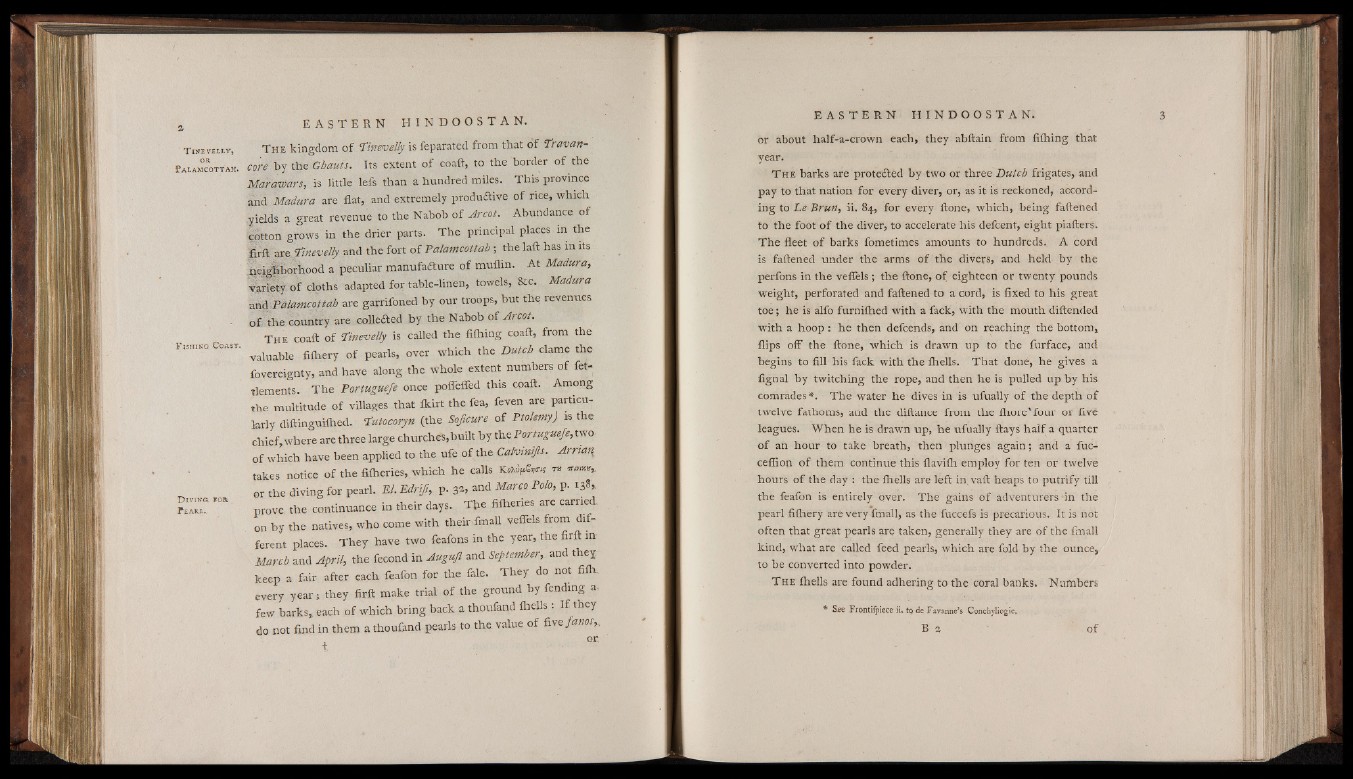
T in ev e l l y ,
OR
fA L AM C O T T A H .
F ishikg. C oast.
D i v i n g roife
Pearl..
T he kingdom of ‘Tinevelly is feparated from that of Travan-
core by the Ghauts. Its extent o f coaft, to the border o f the
Marawars, .is little lefs than a hundred miles. This province
and Madura are flat, and extremely produaive of rice, which
yields a great revenue to the Nabob of Arcot. Abundance of
cotton grows in the drier parts. The principal places in the
firR are Tinevelly and the fort of Palamcottah ; the laft has in its
riei^Kborhood a peculiar manufa&ure o f muflin. At Madura,
variety o f cloths adapted for table-linen, towels, 8tc. Madura
andPalamcottah are garrifoned by our troops, but the revenues
o f the country are colletted by the Nabob of Arcot.
T h e coaft of Tinevelly is called the fiihing coaft, from the
valuable fiihery o f pearls, over which the Dutch clame the
fovereignty, and have along the whole extent numbers of fet-
tlements. The Portuguefe once poffefled this coaft. Among
the multitude of villages that fkut the fea, feven are particularly
diftinguifhed. Tutocoryn (the Soft cure o f Ptolemy) is the
chief, where are three l a r g e churches,built by the Portuguefe, Wo
o f which have been applied to the ufe of the Calvtnifts. Arrian
takes notice o f the filheries, which he calls ■***«***
or the diving for pearl. El. Edrif, p. m and Marco Polo, p. 13^
prove the continuance in their days. The fiihenes are carried
on by the natives, who come with their fmall veffels from different
places. They have two feafons in the year, the firft in
March and April, the fecond in Augujl and September, and they
keep a fair after each feafon for the fale. They do not fifh..
every year; they firft make trial of the ground by fending a,
few harks, each of which bring back a thoufand fliells: If they
do not find in them a thoufend pearls to the value of five/amiy
or.
§
or about half-a-crown each, they abftain from fiihing that
year.
T h e barks are protected by two or three Dutch frigates, and
pay to that nation for every diver, or, as it is reckoned, according
to Le Brun, ii. 84, for every ftone, which, being fattened
to the foot o f the diver, to accelerate his defcent, eight piafters.
The fleet of barks fometimes amounts to hundreds. A cord
is fattened under the arms of the divers, and held by the
perfons in the vefiels; the ftone, of eighteen or twenty pounds
weight, perforated and fattened to a cord, is fixed to his great
toe; he is alfo furniihed with a fack, with the mouth diftended
with a hoop: he then defcends, and on reaching the bottom,
flips off the ftone, which is drawn up to the furface, and
begins to fill his fack with the fhells. That done, he gives a
fignal by twitching the rope, and then he is pulled up by his
comrades*. The water he dives in is ufually of the depth o f
twelve fathoms, and the diftance from the fhore'four or five
leagues. When he is drawn up, he ufually ftays half a quarter
o f an hour to take breath, then plunges again; and a fuc-
ceflion of them continue this flavifh employ for ten or twelve
hours of the day : the lhells are left in.vaft heaps to putrify till
the feafon is entirely over. The gains of adventurers -in the
pearl fiihery are very fmall, as the fuccefs is precarious. It is not
often that great pearls are taken, generally they are of the fmall
kind, what are called feed pearls, which are fold by the ounce,
to be converted into powder.
T h e fhells are found adhering to the coral banks. Numbers
* S#c Frontilpiece ii. tq de F a v an n e ’s Conchyliogie.
B 2 of